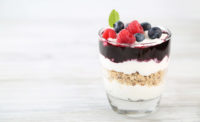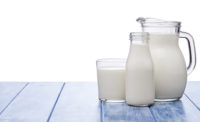2019 State of the Industry: Butter wins a combination ticket
New usage occasions allow butter to draw the winning numbers




It seems that butter producers picked their numbers wisely. The cooking staple and flavor booster continues to show positive growth, with dollar sales of butter/butter blends up 1.3% (to $3,131.4 million) and unit sales jumping 2.5% (to 840.6 million) during the 52-week period ending Aug. 11, 2019, according to data from Chicago-based market research firm IRI.
And it’s not just luck of the draw: Butter is benefitting from consumer perception that eating products with higher fat content is a good bet, said Joe Baird, CEO, Rumiano Cheese Co., Willows, Calif. This is in part due to the popularity of diets such as the ketogenic, which encourages followers to eat high-fat, low-carbohydrate foods.
Milk | Cheese | Cultured | Ice Cream | Butter | Non-dairy Beverages | Ingredients | Exports
“Today customers are much more aware of the benefits of healthy fats,” he added.
While butter is already a high-fat food, consumers are gravitating to label claims of higher butterfat content, said Jim Feeney, senior director of sales for the Michigan Milk Producers Association, Novi, Mich.
“We currently make a higher-fat product option and get requests for even higher,” he said.
Declaring winnings
Butter’s popularity isn’t just tied to the trendiness of high-fat diets. It has staying power because of its many (and increasing) usage occasions. These extend beyond the dairy aisle.
“Trends come and go, but butter has shown true staying power as a delicacy, flavor enhancer and recipe staple,” said Kristel Corson, vice president of sales and marketing, Clover Sonoma, Petaluma, Calif.
In fact, Pune, India-based Market Research Future predicted that the global butter market will have a compound annual growth rate of 4.2% over the forecast period of 2017-2023 in its “Butter Market Research Report.”
“Butter is generally used as a condiment and [is] used in … myriad of applications in the food industry,” the company said. “And new use cases are being increasingly added every day, which is the prime driver of the global butter market.”
Butter is especially benefitting from the growing popularity of meal kit services. According to Janey Hubschman, co-founder of Epicurean Butter, Denver, these services are teaching consumers how to cook at home, and many of the kits include butter.
Corson agreed.
“Meal kits like Blue Apron and Sun Basket have also shown consumers how to use flavored, culinary butters in delicious, unique recipes,” she said.
Epicurean provides butter for Hello Fresh’s meal kits. Additionally, Hubschman said, Epicurean’s products have been included with cut vegetables in grocery store produce sections, with meat or seafood kits sold on QVC and even in delis as part of sandwiches.
“What we have seen in the past 12 months is that we are selling butter into so many different categories and departments in stores,” she said.
Flavored payoff
Many butter companies are releasing flavored butter products to pique the interest of culinary-minded consumers. Clover Sonoma recently introduced three flavors of culinary butter: Garlic & Herb, Lemon Garlic & Herb and Cinnamon & Brown Sugar. The flavors come in 3.5-ounce containers and are easily spreadable.
Chicago-based Medlee Foods launched sweet flavored butter spreads in 2019 to connect with different eating occasions such as breakfast and snacking. They are available in Salted Carmel, Strawberry & Cream, Triple Chocolate, Original Sweet and Cinnamon Roll flavors; they come in a 2.5-ounce tub.
“Consumers are looking for convenience and ease in meal prep, and flavored butters can be part of the solution in cooking and snacking,” said Alberto Valdes, president and CEO, Medlee Foods.
Hitting the health spot
Producers also are finding ways to increase butter’s health halo by adding additional functionality to their offerings.
Vermont Creamery, a subsidiary of Land O’Lakes Inc., Arden Hills, Minn., released an 82% butterfat cultured butter with added live bacterial cultures. It is available in half-pound, two-stick packs in Sea Salt and Unsalted varieties.
According to the company, the cream ferments overnight; by morning, it’s thickened, and notes of buttermilk and hazelnuts have developed. The cream is then churned to 82% butterfat for a rich, creamy texture.
Rumiano Cheese included several butter offerings in its new line of functional nutrition products, which it said have natural inflammatory properties that support overall health and body function.
“Consumers are also cognizant of the fact that the quality and the associated nutritional content of the butter matters,” Baird said.
Rumiano’s new organic grass-fed ghee, for example, is packed with vitamins, nutrients and healing properties. It comes in Original, Garlic, Sea Salt and Turmeric & Black Pepper flavors.
The company also released Rumiano Regenerative Butter, which it said is an organic grass-fed butter that boosts energy, focus and brain function.
Calling for more
So is there a downside right now to being in butter? According to Hubschman, not really.
“There is not a better time to be in the butter business,” she said. “Our challenge really is keeping up with demand.
Baird concurred that supply is the biggest issue right now. Rumiano Cheese Co. has seen a spike in demand earlier in the
year than before, and it can be a struggle to keep up.
As for competition from nondairy alternatives? Hubschman said that’s not much of an issue.
“I believe that real butter and real food is what consumers want,” she added.
Milk | Cheese | Cultured | Ice Cream | Butter | Non-dairy Beverages | Ingredients | Exports
Looking for a reprint of this article?
From high-res PDFs to custom plaques, order your copy today!








